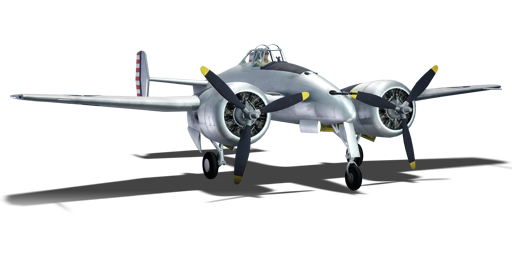



In 1939, the U.S. Army issued Circular Proposal 39-775 for new fighters that could utilize new engines. Of the four companies that submitted designs, Grumman submitted Design 41 which was largely based on Design 34 (XF5F-1) but would utilize two Wright R-1820 radial engines. Although Lockheed’s design was deemed more favorable, the Army wanted Grumman to continue revising Design 41 as a backup in case Lockheed’s proposal ran into hiccups. Grumman’s resubmission, Design 45, was later given the designation XP-50. The XP-50 was fitted with two Wright R-1820-67/69 radial engines which produced 1,200 hp with the help of turbosuperchargers. The XP-50 was promising in test flights until a turbosupercharger explosion led to the loss of the prototype. The XP-50 project was then canceled.
Introduced as a premium aircraft in Update 1.31, the XP-50 is an extremely capable aircraft. With the help of an airspawn, the XP-50 can reach heights well above enemy aircraft with ease. Although it is quite manoeuvrable, at higher speeds the XP-50 struggles with compression. Players must be careful when diving for opponents, especially with how quickly the XP-50 gains speed and the lack of airbrakes. The XP-50 also has two 20 mm cannons and two 12.7 mm machine guns mounted in the nose. However, the cannons are greatly limited in their ammo pool. Nonetheless, the XP-50 is a great plane for beginners to practice energy fighting and ammo conservation.
flaps
flaps
flaps
brake
| Belt | Belt filling | Armor penetration (mm) at a distance: | |||||
|---|---|---|---|---|---|---|---|
| 10 m | 100 m | 500 m | 1000 m | 1500 m | 2000 m | ||
| HEF-I/AP-T | 39 | 36 | 25 | 16 | 10 | 6 | |
| AP-T/AP-T/HEF-I/HEF-I | 39 | 36 | 25 | 16 | 10 | 6 | |
| HEF-I/HEF-I/HEF-I/AP-T | 39 | 36 | 25 | 16 | 10 | 6 | |
| AP-T/AP-T/AP-T/HEF-I | 39 | 36 | 25 | 16 | 10 | 6 | |
| HEF-I | 5 | 4 | 3 | 3 | 3 | 3 | |
| Belt | Belt filling | Armor penetration (mm) at a distance: | |||||
|---|---|---|---|---|---|---|---|
| 10 m | 100 m | 500 m | 1000 m | 1500 m | 2000 m | ||
| T/Ball/Ball/I/AP-I | 28 | 26 | 18 | 11 | 7 | 4 | |
| AP-I/AP-I/AP-I/T/I | 28 | 26 | 18 | 11 | 7 | 4 | |
| T/AP/AP/AP/AP-I/I | 30 | 27 | 20 | 13 | 9 | 6 | |
| T/T/T/T/T/AP-I | 28 | 26 | 18 | 11 | 7 | 4 | |
| AP/AP-I/AP-I/I/I | 30 | 27 | 20 | 13 | 9 | 6 | |







 2 x (65 / 225 / 345) %
2 x (65 / 225 / 345) % 
 2 x 148 %
2 x 148 % 

Flight performance | |
|---|---|
Survivability |
|---|
Weaponry |
|---|